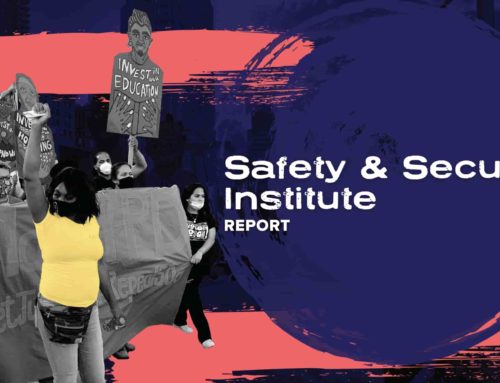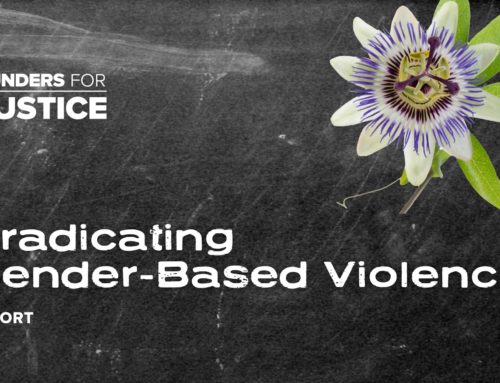I often think of Darnella Frazier, the 17-year-old Black girl who filmed police “lynching” George Floyd on May 25. The video went viral and moved the United States and the world to mass protests against police brutality and racial injustice. It was the spark that contributed to this unprecedented movement for justice that we are currently witnessing, experiencing and organizing.
But in the midst of this uprising, this young woman experienced a traumatic event. Yet she still had the foresight to share it with the world. Later, on video, she appears visibly upset and rightfully so. She told the reporter in between sobs, “I watched this man die…It was so traumatizing.” To add insult to injury, she then received threats for sharing the video.
What kind of support did Darnella receive? Who protected her?
While the world watched and was moved to action, I fear our children, who experience this trauma with us, are being overlooked. These horrifying incidents can have a lingering impact on them and shape who they become.
This, to me, begs the question: How do we protect the mental, physical and emotional state of our children? I think particularly of Black girls, who are dangerously stuck at the intersection of racism and sexism in the United States today.
The Intersection of Racism and Sexism
Black people often experience racism, but what gets lost is how these traumatic experiences shape the psyche and challenges the security that our children feel. What is America telling Black girls who hear or read about the murder of Breonna Taylor in her own bed while she was sleeping, when the police who shot her are not arrested for months? How are they processing that information? For Black girls, these experiences can be life-altering.
According to the Black Women’s Blueprint, 60 percent of Black girls in this country have experienced sexual abuse at the hands of Black men before reaching the age of 18, yet the vast majority of incidents go unreported.
Furthermore, Black girls are steeped in a media environment that is bombarded daily with overly sexualized images of girls and women. This impacts how the world views Black girls and how they view themselves. A recent Georgetown Law study showed that adults view Black girls as more adult-like and less innocent than White girls, starting as early as the age of 5. The term “adultification” is used to explain this practice, which may be subconscious. But I’ve seen with my own eyes how Black girls are treated as if they are older, need less support and are more sexually aware than they really are.
The Creation of the Southern Black Girls and Women’s Consortium
While I admire what the Obama administration did with Black boys and men through My Brother’s Keeper, I can’t help but ask what about the girls and young women? Statistically, Black girls need that intervention even more.
A few years ago, a report titled Unequal Lives by the Southern Rural Black Women’s Initiative, highlighted that of the $4.8 billion in philanthropic investments allocated to the South, just 5.4 percent went to programs focused on women and girls and less than 1 percent to programs focused on Black women and girls. This new information bothered me so much that for days I tried to figure out what I could do as an intervention to turn that statistic around. That was how the Southern Black Girls and Women’s Consortium (SBGWC) was created. And it was intentional that girls came first in the name, because we have to center Black girls, who are most vulnerable.
Our organization hosted and collected data from listening sessions and focus groups in 12 states with Black girls and young women, ages 9 to 24, and those that work with them, including psychologists, teachers, social workers, juvenile justice officials, disabled and immigrant community leaders.
Our study revealed many things, among them that Black girls are acutely aware of racism, the economic instability of their households and the safety of their loved ones. They are watching what is happening to us and are feeling very stressed about it.
Our data also showed that while our girls feel smart enough to maneuver in life, they don’t feel like they are smart in school. This is not a reflection of them, but the systems and institutions that have allowed our children to diminish their own brilliance. Black girls are shaping the culture of the world, but we send them off to institutions where they feel inferior to their counterparts. That has to change.
A Look Ahead
So, where do we go from here? Here are some ideas to put into action:
Black girls need better representation in media and entertainment. We have to hold the entertainment industry accountable for its portrayal of our girls as objects and choosing to neglect the fullness of their humanity. They cannot continue to exploit Black women or play into stereotypes. In addition, newsrooms are less than 17 percent people of color. We are underrepresented and misrepresented on the screen and behind the camera.
Black girls need space to create and lead. Many girls grow up hearing, “You should be seen and not heard,” or being labeled as “fast.” Those messages are damaging. We need to give Black girls the space to shine brightly and to use their words to express themselves. We have to stop stripping away their innocence and allow them to express their own femininity. If not, we are stifling their creativity and limiting their ability to be who they are. The way they dance and wear their hair should not make them victims. Instead, let’s focus on creating more safe places for Black girls to lean into their truth and discover who they are.
Black girls need investment. We need foundations to support two generational strategies for Black girls and those who support them. Our goal through SBGWC is to build a $100 million fund that will create the infrastructure for regional grantmaking and movement-building for Black girls and women.
Here’s an example of our work: While many children are stuck at home and away from friends due to COVID-19, SBGWC created a Black Girl Joy Challenge. We asked Black girls to create an idea that would bring Black girl joy to themselves and 10 other people. SBGWC would then give them a $250 stipend to invest in their idea and put it into action.
We received so many messages from families saying this was the first time they had ever won anything. Many cried when they found out they were selected, not because of the money, but because someone said I see you and you matter. Investing a little can create so much.
As these Black girls stepped into their power to create solutions for their community, they were able to have agency. They are not victims, but victors. They are not problems, but problem-solvers.
Oprah Winfrey, Beyoncé, Ida B. Wells, Ledisi, Fannie Lou Hamer, to name a few, are all Black women from the South who went on to thrive in their respective fields and greatly impact the world despite the racism, discrimination and barriers they faced growing up. So we know what is possible, because we have examples of Black girls who were able to use their gifts to change the world. But we need this to be the rule, not the exception.
While we are in this deeply reflective moment in this country, let’s remember that Black girls deserve to live in a world where they can dream with unlimited options and stand in the fullness of who they are so their voices can be seen, heard and valued. And the way we do that, the way to love and protect Black girls, is to invest in them, listen to them and support them as leaders. When we do this, when we allow more Black girls to own their power and give them space and opportunity to think and create, they will soar.
LaTosha Brown is the visionary, social justice activist and co-anchor of the Southern Black Girls and Women’s Consortium and co-founder of Black Voters Matter Fund. You can follow her on Twitter @MsLaToshaBrown.



